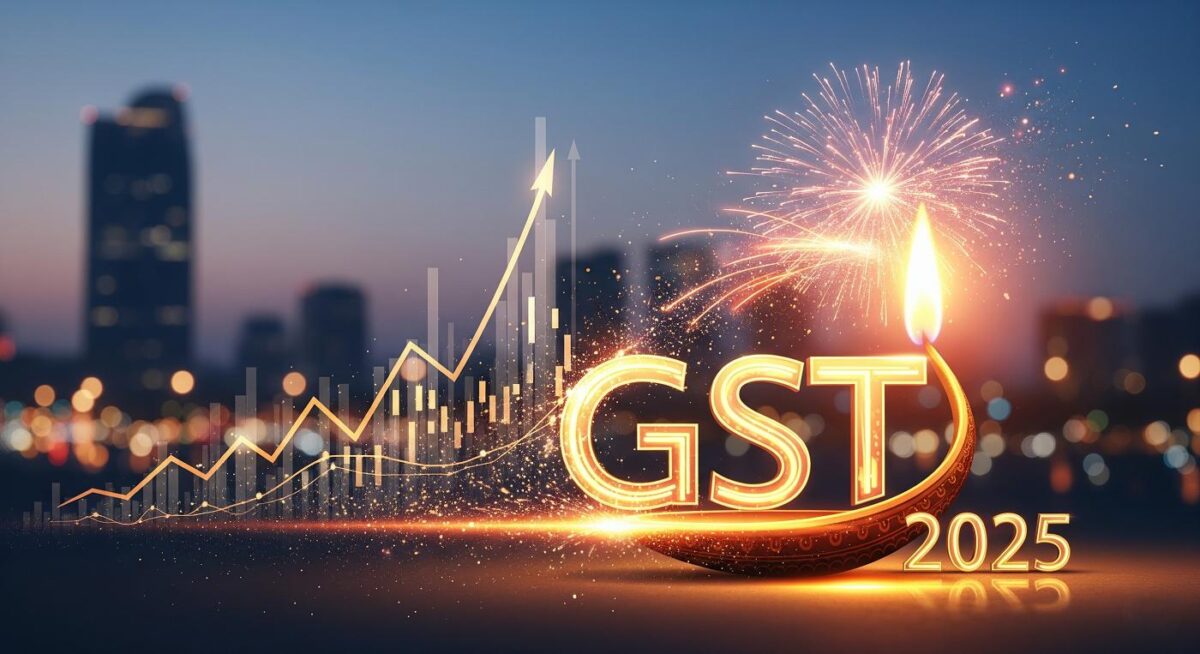On August 15, 2025, Prime Minister Narendra Modi unveiled a landmark economic initiative, GST Reforms 2.0, promising a “double Diwali” for citizens and businesses alike. The reforms aim to simplify India’s Goods and Services Tax (GST) system, reduce rates on essential goods, and provide a strong boost to the economy. Implementation is scheduled to coincide with Diwali 2025, aligning the reforms with festive-season spending to maximize economic impact.
The announcement has triggered significant market optimism, with analysts identifying over 40 stocks across various sectors that stand to benefit from the sweeping changes.
Key Highlights of GST Reforms 2.0
- Simplified Tax Structure: The reforms introduce a more streamlined tax system, consolidating multiple GST slabs into just two main rates – 5% and 18%. This simplification reduces compliance burden for businesses and makes pricing more transparent for consumers.
- Targeted Rate Reductions: Essential items, including food products, personal care, electronics, cement, and small automobiles, are expected to see reduced GST rates. This is likely to increase demand across these categories, benefitting companies operating in these sectors.
- Economic Stimulus: The GST reforms are expected to provide a significant boost to the economy, with projected increases in consumption and GDP. Analysts anticipate an increase in demand worth several lakh crores, creating opportunities for growth across retail, manufacturing, and services sectors.
- Ease of Compliance: The government has introduced measures to simplify return filing and reduce procedural complexities, encouraging businesses, particularly small and medium enterprises, to formalize their operations and expand their reach.
Sectors Poised for Growth
1. Automobile Sector
Small car manufacturers and two-wheeler producers are set to gain the most from reduced GST rates on vehicles. Companies in this sector can expect increased sales volumes as lower taxes make vehicles more affordable for the average consumer.
2. Cement Industry
GST cuts on cement and building materials are likely to stimulate demand in the construction sector. Large cement producers are expected to see higher sales volumes and revenues, benefiting from both residential and infrastructure projects.
3. Consumer Goods
FMCG companies stand to benefit as lower tax rates on everyday items like food, personal care, and household products are expected to drive higher consumption. Companies that operate in packaged foods, beverages, and hygiene products are likely to experience a surge in demand.
4. Financial Institutions
Banks and financial companies are set to gain indirectly. With increased consumer spending and business activity, demand for loans, credit, and financial services is expected to rise, boosting the performance of major private and public sector banks.
5. Retail and E-commerce
The retail and e-commerce sectors are poised for growth as simplified taxation reduces product costs and encourages online and offline purchases. Companies in logistics, delivery, and digital marketplaces may see increased transaction volumes and higher revenues.
6. Electronics and Appliances
Reduction in GST on electronics and home appliances is expected to benefit manufacturers and retailers alike. Lower taxes can increase sales, especially during the festive season, providing a boost to companies dealing in consumer electronics.
Market Reaction and Investor Sentiment
The announcement of GST Reforms 2.0 has generated significant excitement in the stock market. Analysts predict a positive impact on over 40 key stocks in automobile, cement, FMCG, banking, and retail sectors. Investors are optimistic about the anticipated economic stimulus, with the reforms expected to enhance corporate earnings, increase consumer spending, and improve market liquidity.
Many investors are now closely monitoring sectoral performance, focusing on stocks that are likely to see maximum benefit from reduced GST rates. Analysts also believe that these reforms could attract both domestic and foreign investment, reinforcing long-term growth potential for the Indian market.
Long-Term Implications
- Boost to Domestic Consumption: Lower GST rates on essential goods and consumer products are expected to encourage higher spending, fueling growth in the domestic market.
- Increased Investment: Simplified compliance and clear tax structures make India a more attractive destination for investment, particularly for sectors that have previously faced regulatory hurdles.
- Enhanced Competitiveness: Indian companies are likely to become more competitive both domestically and internationally due to lower input costs and efficient tax systems.
- Sectoral Opportunities: Over 40 identified stocks spanning multiple sectors are expected to witness growth, creating investment opportunities for both short-term gains and long-term portfolio expansion.
Conclusion
The GST Reforms 2.0 initiative, announced by PM Modi on August 15, 2025, marks a significant milestone in India’s economic journey. By simplifying taxes, reducing rates on essential goods, and boosting consumption, these reforms are set to positively impact over 40 stocks across various sectors. With implementation aligned to Diwali 2025, the festive season is expected to see a surge in spending, making it a strong growth period for businesses and investors alike.
India’s financial and corporate landscape is poised for transformation, with GST Reforms 2.0 acting as a catalyst for growth, investor confidence, and market optimism.









